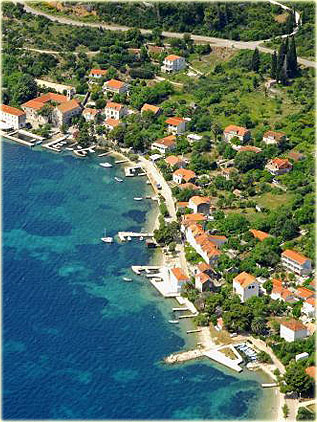
The village of Viganj is a small settlement with approximately 300 permanent inhabitants, located on the southwestern part of the peninsula of Peljesac, guarding the western entrance to the channel of Peljesac, an ancient maritime route between north and south Adriatic sea. Viganj stretches along large bay, enclosed by cape St. Liborius to the east and cape of St. John to the west. Viganj overlooks villages of Kneze and Tri Zala on the island of Korcula across Peljesac channel. Viganj is located below mountain top St. Elias (961 m), on the southern, fertile slopes of the peninsula Peljesac, the most famous Croatian wine growing area. Viganj is part of the municipality of Orebic, and it is located 8 kilometres to the west from the town of Orebic, on the main road that connects the peninsula of Peljesac with the rest of the world. Ancient walled town of Korcula is located just across the channel of Peljesac and it is easily reachable by ferry from nearby Orebic. The world famous town of Dubrovnik is located 130 kilometres to the south.
The climate in Viganj is very mild, since it is protected from cold northern winds, and oriented towards the south. The seafarers of Viganj during history brought many different types of plants and fruits from their journeys around the world, so the entire place resembles a large and living botanical garden, carefully nurtured over many generations, receiving warm Mediterranean sunlight for more than 260 sunny days per year, which is around 3600 sun hours yearly. The sea temperature never drops below 15 degrees, and from early spring to late autumn abounds with mistral, cool northwestern wind that blows here averaging 5 Beaufort scale and sometimes reaching up to 8. Mistral (local name: maestral) blows along the coast and it is strictly a surface wind. It starts blowing around 10 AM and around 2 PM mistral reaches its maximum and always ends before sunset (usually up to 6 PM). Mistral is accompanied by good weather and significantly alleviates the summer sultriness.
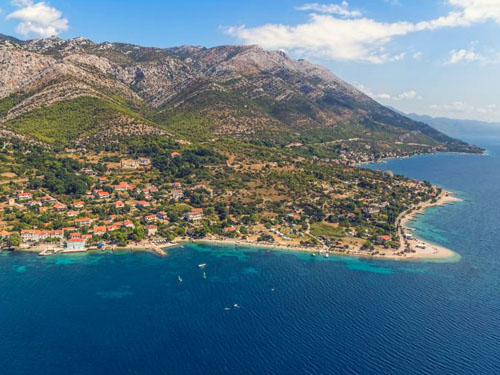
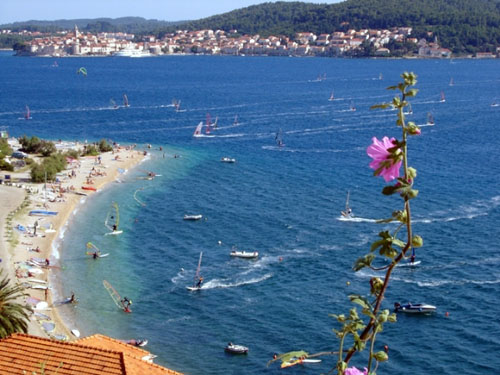
Viganj is an isolated village, located in a quiet, natural setting, without excessive amounts of car traffic, and without too much haste, even in the main touristic season. The main source of income for local population is tourism, agriculture and fishing, and hroughout history, the main economic activity for the inhabitants of Viganj was seafaring. With regards to tourism, Viganj is best described as the centre of active holiday in south Dalmatia. But what makes this place unique are, more than anything else, people. Therefore Viganj is not only an oasis lovers of sports, but also a paradise for all those longing for flavour, taste and spirit of the Mediterranean as it once was. In Viganj you can really experience the authentic atmosphere of the Mediterranean village, as you stroll along the meandering coastline, between beautiful beaches and houses of authentic architecture surrounded by blossoming gardens.
Viganj has very long tradition in tourism - the first tourist organisation in Viganj was established in year 1936. Viganj is the most popular tourist destination for active holiday in southern Dalmatia - it is known throughout the world for excellent conditions for sailing, freeclimbing, surfing and hiking. Viganj is world renowned place for people who are engaged in water sports, especially windsurfing and kitesurfing. It hosts a variety of Croatian, European and world windsurfing regattas, competitions and championships. In Viganj there are many private houses and villas for rent, and visitors in particular appreciate homegrown products. Swimmers will be delighted by a large pebble beaches and pine groves, some of which are isolated and popular with naturists.
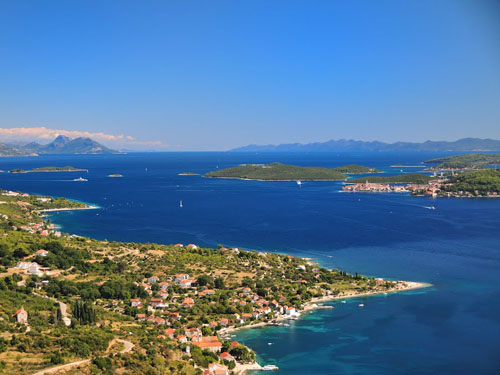
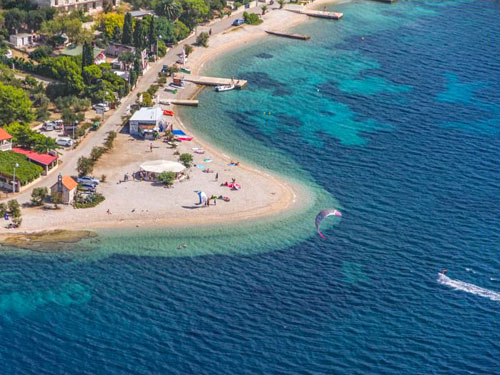
The vicinity of beautiful towns and attractions will make your stay in Viganj fulfilled, and the sufficient distance from the tourist crowds will provide a quiet, relaxing vacation. The island of Korcula is located just across the Peljesac channel, and the island of Mljet across the channel of Mljet. The slopes of the "Gradina" hill are very popular among free-climbers. Hunters and hikers enjoy the benefits of St. Elias hill from where the view of the entire South Adriatic. Beautiful promenade, 4 kilometres long, with many beautiful pebble beaches, restaurants and beach bars stretches to the west between Viganj and Kuciste. To the east from Viganj there are several secluded pebble beaches (some are accessible by boat only) which are very popular among nudists. Further to the east, the coast of the Peljesac peninsula is very steep, with only one small bay and a beach where very nice restaurant is located. This is just one of many nice traditional restaurants in Viganj that offer excellent local dishes and wines.
The channel between the island of Korcula and Viganj is packed with colourful surf and kite sails and provides an impressive picture. At the main beach in Viganj, Ponta, there are two windsurfing centers that provide a variety of services, from the rental of equipment to different courses for both beginners and for those more advanced. At the Ponta beach you can also rent bikes, play volleyball on the beach and get into scuba diving.
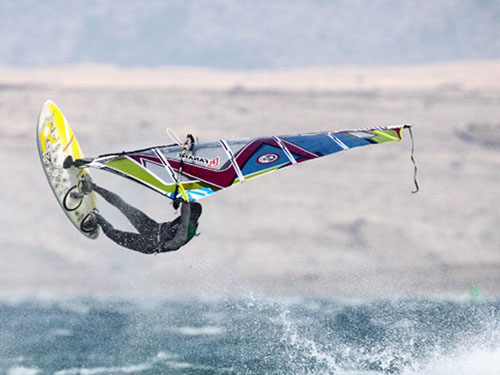
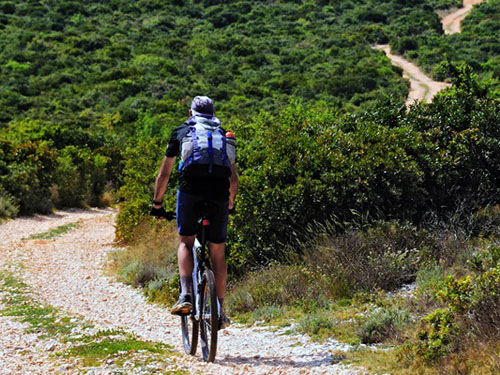
There are many suitable trails for mountain biking and trekking, and lovers of flora and fauna can enjoy and photograph some very rare plants, rich medicinal flora and animal species (moufflon, wild boar, pheasants). Goat trails, meadows and rocky terrain are ideal for extreme cycling and rock climbing.
Viganj is filled with small pebble beaches and it has two naturist beach beneath the church of St. John. The place has several charming bars and small restaurants, ideal for enjoying a serene Mediterranean summer, with the taste of fish seasoned with excellent locally grown olive oil and a glass of the world known Peljesac wine.
Nakovane is one of the oldest settlements on the peninsula Peljesac. Archaeological research has established that the settlement was inhabited for more than 8000 years. Located few kilometres from Viganj, this today abandoned place hides many ancient legends. Along the way from Viganj to Nakovane one can see fossilised sea shells, and in the village and surrounding area there are many cultural and historical monuments. One of them is cave "Spila Nakovana", one of the richest sites of the Illyrian culture in the world. Archaeological findings around and in the cave date back to the early Neolithic period (about 6000 BC) until the end of the Late Iron Age (1st century BC). The discovery of the cave in 1999. became a worldwide sensation in professional circles. Findings consist mainly of fine ceramic dishes, mostly imported from Greece and from Greek colonies in southern Italy and the central Dalmatian islands. Nearby there are ruins of ancient Illyrian town on the "Gradina" hill, Illyrian sanctuary and Illyrian burial grounds and several medieval churches. In the area of Nakovana there are over 150 plant species, 29 animal species, numerous birds and 47 butterfly species.
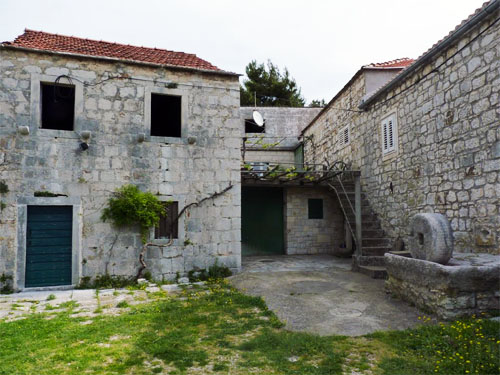
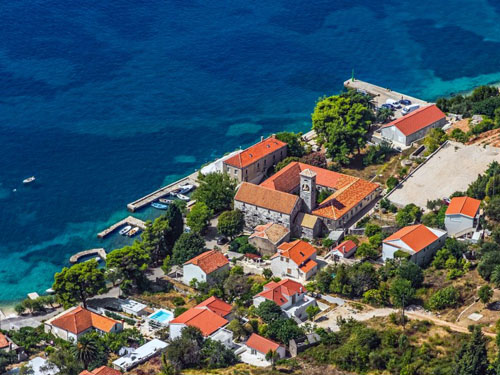
The parish church of St. Michael in Viganj was erected in the Gothic era, and in 1760 it was annexed. Surrounded with vineyards and olive groves, the church of St. John from 14th century located on the top of the hill features a unique view on the Peljesac channel and sunsets. On the cape of St. Liborius, the church of St. Liborius was built 18th century.
In the year of 1671 the shipowner Marko Krstelj began te construction of the Dominican monastery and the church of Our Lady of the Rosary, located in the central part of Viganj. The Dominican church is a single nave structure, with the statue of the Virgin Mary on the high altar. The church houses wooden statue of Madonna and Child, a Renaissance bust of a saint and a painting of the "Battle of Lepanto". Alongside the church the cloister with simple arcades is located. The monastery features an enclosed garden, on of the most beautiful in southern Dalmatia. Since this entire complex was privately owned by family Krstelj, upon it's decline it slowly detoriated (except for the church building), and in 1910. it was bought by the people and Viganj and renovated to serve as a school and a library. Today the monastery serves as a cultural centre.






